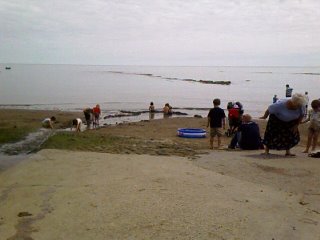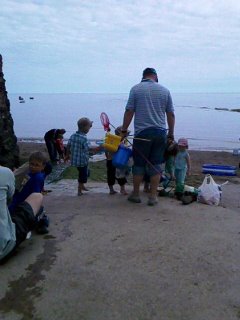 I had planned to stay an extra day at Robin Hood’s Bay, and am glad I did. I want to relish the completion of the Coast to Coast walk. Most of my friends left the day after they arrived. Michael and David headed back within hours of finishing on that rainy Wednesday...sopping and singing and changing clothes in the back of the Sherpa van that came to return them to Richmond for the drive home.
I had planned to stay an extra day at Robin Hood’s Bay, and am glad I did. I want to relish the completion of the Coast to Coast walk. Most of my friends left the day after they arrived. Michael and David headed back within hours of finishing on that rainy Wednesday...sopping and singing and changing clothes in the back of the Sherpa van that came to return them to Richmond for the drive home. The morning is easy. Sleep in ’til 7:30, eat breakfast at 8, say goodbye to Marv, nap again ’til 10. Walk into town and buy postcards and a replacement shirt for the two I’ll be tossing soon. They got seriously faded in bands across the shoulders and the front from sweat and the backpack and repeated washings these past two weeks.
The morning is easy. Sleep in ’til 7:30, eat breakfast at 8, say goodbye to Marv, nap again ’til 10. Walk into town and buy postcards and a replacement shirt for the two I’ll be tossing soon. They got seriously faded in bands across the shoulders and the front from sweat and the backpack and repeated washings these past two weeks. I wander around a lot today. My feet don’t seem to want to stay still after all that walking. They also don’t want to be in shoes, so I get to feel the sand and asphalt and stones of Robin Hood’s Bay and its village a lot of the day.
I wander around a lot today. My feet don’t seem to want to stay still after all that walking. They also don’t want to be in shoes, so I get to feel the sand and asphalt and stones of Robin Hood’s Bay and its village a lot of the day.


 I buy a strawberry ice cream from the on-the-beach ice cream van, meander the labyrinth of skinny side streets and stone steps, sit on the slipway watching beach goers.
I buy a strawberry ice cream from the on-the-beach ice cream van, meander the labyrinth of skinny side streets and stone steps, sit on the slipway watching beach goers.The day is another hot one, and people are out with beach shovels and pails, plastic dump trucks, romping dogs, inflatable rafts, plastic fish nets on 4' bamboo poles in pink, blue, green, yellow. Up a hill and around the corner from the Maritime Museum, some kind resident has propped a whole collection of these colored fish nets for free use—quiet competition to the shops at the top of the hill that sell them for a few pounds apiece.


 Families and children are digging sand, making walls against the tide that overruns them as quickly as they’re built. People push strollers along the packed sand, up and over cobbles on the slipway, through rivulets of water running to the sea from the town’s stream. There is a strong smell of sea today: a muggy, seaweedy smell. A sweet fragrance of pipe tobacco passes by—he is the only pipe smoker I’ve come across this trip.
Families and children are digging sand, making walls against the tide that overruns them as quickly as they’re built. People push strollers along the packed sand, up and over cobbles on the slipway, through rivulets of water running to the sea from the town’s stream. There is a strong smell of sea today: a muggy, seaweedy smell. A sweet fragrance of pipe tobacco passes by—he is the only pipe smoker I’ve come across this trip.The tide is much higher than it was yesterday at 3:30 when I got in. I am getting eaten by beach flies where I sit, so I decide on a water walk.
 This beach and how people enjoy it is very different from Wight, Cornwall, St Bees. There are no miles of hotels, sand, and beach houses like at Wight; no rugged boulders and crashing waves like at Cornwall; no evenly spaced jetties and water-level boardwalk like at St Bees. Here is a towering seawall built to bolster the village from dropping into the sea. Beach that disappears rapidly with the tide; a main street that slides directly to the water; boardwalks along the top of the seawalls; concrete ramps and steps that lead down to the sand at low tide and are barricaded with chains at high tide.
This beach and how people enjoy it is very different from Wight, Cornwall, St Bees. There are no miles of hotels, sand, and beach houses like at Wight; no rugged boulders and crashing waves like at Cornwall; no evenly spaced jetties and water-level boardwalk like at St Bees. Here is a towering seawall built to bolster the village from dropping into the sea. Beach that disappears rapidly with the tide; a main street that slides directly to the water; boardwalks along the top of the seawalls; concrete ramps and steps that lead down to the sand at low tide and are barricaded with chains at high tide. A boy and his dad have made a sand boat at the base of the northern seawall. The flags are fish nets stuck up at each side. The boy sits on a towel in the boat, “Because,” his mother explains to me, “he hates to sit in the sand.” They soon have to abandon ship with the swamping tide.
A boy and his dad have made a sand boat at the base of the northern seawall. The flags are fish nets stuck up at each side. The boy sits on a towel in the boat, “Because,” his mother explains to me, “he hates to sit in the sand.” They soon have to abandon ship with the swamping tide. Waters overtake another deserted sand fort, and farther on three children are desperately trying the protect the stronghold they’ve abutted to the seawall.
Waters overtake another deserted sand fort, and farther on three children are desperately trying the protect the stronghold they’ve abutted to the seawall.I admire their work.
“My brother likes building castles,” says a girl of the trio. She’s the eldest, about 11.
“How long has it taken you?”
“All day!” proclaims the boy, whose citadel this is. “We’ve been here since eight in the morning!”
It is about noon now.
“This is the castle.” The girl hikes over the mounds and points to a pile of sand the size of a grapefruit that’s molded against the wall. The castle keep. They’ve surrounded it with semicircles of ditches and high walls—the builders of Old Sarum Mound in Salisbury couldn’t have done it better.
 “This one’s called The Flying Cape Castle,” says the boy as he and his sisters fortify the third ring of sand against the incoming sea. Their father comes by and we chat a bit. They’re from Suffolk, Cambridge area.
“This one’s called The Flying Cape Castle,” says the boy as he and his sisters fortify the third ring of sand against the incoming sea. Their father comes by and we chat a bit. They’re from Suffolk, Cambridge area.The girl chimes in, “We’ve been coming here for holiday every year since I was born.”
The father laughs: “I’ve been coming here every year since I was born.” He points to his kids. “They’ve been at this since before breakfast. I came to find them for lunch.”
The tide has come in enough that my way back to the slipway is now under water along the seawall. I say goodbye and slosh back to town to find a bit of lunch myself.
Not in the mood for a pub, I retrace the line of people walking around with fish-and-chips containers and end up at a take-out up one of the village’s angling side streets. The shop is so tiny and narrow that patrons form a U-turn queue through its single door, entering to place an order and leaving with their hands full of hot goods. “’Scuse me, ’scuse me, oh I’m so sorry,” as we all bump shoulders to make way for each other while advancing to our next place in line.
 The servers are sassy twenty-somethings, all men, and loving their popularity at the busy lunch hour. I drop a tip into their “Staff Beer Fund” as recompense for the photo I take, and one of them says, “Thank you miss. For that, you get something extra.” He lays one extra chip speared with a wooden fork onto my meal box. “See that, folks?” he says to the rest of the patrons. “Generosity never goes unrewarded.”
The servers are sassy twenty-somethings, all men, and loving their popularity at the busy lunch hour. I drop a tip into their “Staff Beer Fund” as recompense for the photo I take, and one of them says, “Thank you miss. For that, you get something extra.” He lays one extra chip speared with a wooden fork onto my meal box. “See that, folks?” he says to the rest of the patrons. “Generosity never goes unrewarded.”
 Blowing the heat off the fish and chips, I take a bench at the upper boardwalk for more people watching from the overview point. A fellow next to me plays Sudoku. The sun keeps coming and going, brilliant and hot when it’s not behind clouds, which is where it’s been most of the day.
Blowing the heat off the fish and chips, I take a bench at the upper boardwalk for more people watching from the overview point. A fellow next to me plays Sudoku. The sun keeps coming and going, brilliant and hot when it’s not behind clouds, which is where it’s been most of the day.I visit the Maritime Museum at see interesting displays of how tides work (a working model of the moon, the earth spinning, and a diorama of the sea rising and falling along the shore of Robin Hood’s Bay).
 The Morris dancers are still here, so I catch a more of their show and mostly hang around the village for the rest of the day. I am feeling like a tourist again, only different. More able to sit and just be here. That is enough for now.
The Morris dancers are still here, so I catch a more of their show and mostly hang around the village for the rest of the day. I am feeling like a tourist again, only different. More able to sit and just be here. That is enough for now.